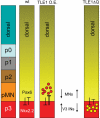Establishment of motor neuron-V3 interneuron progenitor domain boundary in ventral spinal cord requires Groucho-mediated transcriptional corepression
- PMID: 22363571
- PMCID: PMC3281934
- DOI: 10.1371/journal.pone.0031176
Establishment of motor neuron-V3 interneuron progenitor domain boundary in ventral spinal cord requires Groucho-mediated transcriptional corepression
Abstract
Background: Dorsoventral patterning of the developing spinal cord is important for the correct generation of spinal neuronal types. This process relies in part on cross-repressive interactions between specific transcription factors whose expression is regulated by Sonic hedgehog. Groucho/transducin-like Enhancer of split (TLE) proteins are transcriptional corepressors suggested to be recruited by at least certain Sonic hedgehog-controlled transcription factors to mediate the formation of spatially distinct progenitor domains within the ventral spinal cord. The aim of this study was to characterize the involvement of TLE in mechanisms regulating the establishment of the boundary between the most ventral spinal cord progenitor domains, termed pMN and p3. Because the pMN domain gives rise to somatic motor neurons while the p3 domain generates V3 interneurons, we also examined the involvement of TLE in the acquisition of these neuronal fates.
Methodology and principal findings: A combination of in vivo loss- and gain-of-function studies in the developing chick spinal cord was performed to characterize the role of TLE in ventral progenitor domain formation. It is shown here that TLE overexpression causes increased numbers of p3 progenitors and promotes the V3 interneuron fate while suppressing the motor neuron fate. Conversely, dominant-inhibition of TLE increases the numbers of pMN progenitors and postmitotic motor neurons.
Conclusion: Based on these results, we propose that TLE is important to promote the formation of the p3 domain and subsequent generation of V3 interneurons.
Conflict of interest statement
Figures





Similar articles
-
Sp8 plays a supplementary role to Pax6 in establishing the pMN/p3 domain boundary in the spinal cord.Development. 2014 Jul;141(14):2875-84. doi: 10.1242/dev.105387. Epub 2014 Jun 19. Development. 2014. PMID: 24948600
-
Genetic dissection of Gata2 selective functions during specification of V2 interneurons in the developing spinal cord.Dev Neurobiol. 2015 Jul;75(7):721-37. doi: 10.1002/dneu.22244. Epub 2014 Nov 15. Dev Neurobiol. 2015. PMID: 25369423
-
Pax6 is expressed in subsets of V0 and V2 interneurons in the ventral spinal cord in mice.Gene Expr Patterns. 2013 Dec;13(8):328-34. doi: 10.1016/j.gep.2013.06.004. Epub 2013 Jun 29. Gene Expr Patterns. 2013. PMID: 23816521
-
New perspectives on the mechanisms establishing the dorsal-ventral axis of the spinal cord.Curr Top Dev Biol. 2019;132:417-450. doi: 10.1016/bs.ctdb.2018.12.010. Epub 2018 Dec 26. Curr Top Dev Biol. 2019. PMID: 30797516 Free PMC article. Review.
-
Insights into the mechanisms of neuron generation and specification in the zebrafish ventral spinal cord.FEBS J. 2024 Feb;291(4):646-662. doi: 10.1111/febs.16913. Epub 2023 Aug 3. FEBS J. 2024. PMID: 37498183 Review.
Cited by
-
Generating spinal motor neuron diversity: a long quest for neuronal identity.Cell Mol Life Sci. 2014 Mar;71(5):813-29. doi: 10.1007/s00018-013-1398-x. Epub 2013 Jun 14. Cell Mol Life Sci. 2014. PMID: 23765105 Free PMC article. Review.
-
Deciphering principles of morphogenesis from temporal and spatial patterns on the integument.Dev Dyn. 2015 Aug;244(8):905-20. doi: 10.1002/dvdy.24281. Epub 2015 Jul 6. Dev Dyn. 2015. PMID: 25858668 Free PMC article.
-
Motor neurons and the generation of spinal motor neuron diversity.Front Cell Neurosci. 2014 Oct 9;8:293. doi: 10.3389/fncel.2014.00293. eCollection 2014. Front Cell Neurosci. 2014. PMID: 25346659 Free PMC article. Review.
-
Analyses of binding partners and functional domains for the developmentally essential protein Hmx3a/HMX3.Sci Rep. 2023 Jan 20;13(1):1151. doi: 10.1038/s41598-023-27878-9. Sci Rep. 2023. PMID: 36670152 Free PMC article.
-
Prolyl isomerase Pin1 and protein kinase HIPK2 cooperate to promote cortical neurogenesis by suppressing Groucho/TLE:Hes1-mediated inhibition of neuronal differentiation.Cell Death Differ. 2014 Feb;21(2):321-32. doi: 10.1038/cdd.2013.160. Epub 2013 Nov 22. Cell Death Differ. 2014. PMID: 24270405 Free PMC article.
References
-
- Briscoe J, Ericson J. Specification of neuronal fates in the ventral neural tube. Curr Opin Neurobiol. 2001;11:43–49. - PubMed
-
- Zhuang B, Sockanathan S. Dorso-ventral patterning: a view from the top. Curr Opin Neurobiol. 2006;16:20–24. - PubMed
-
- Dessaud E, McMahon AP, Briscoe J. Pattern formation in the vertebrate neural tube: a sonic hedgehog morphogen-regulated transcriptional network. Development. 2008;135:2489–2503. - PubMed
-
- Lupo G, Harris WA, Lewis KE. Mechanisms of ventral patterning in the vertebrate nervous system. Nat Rev Neurosci. 2006;7:103–114. - PubMed
-
- Lu QR, Yuk D, Alberta JA, Zhu Z, Pawlitzky I, et al. Sonic hedgehog-regulated oligodendrocyte lineage genes encoding bHLH proteins in the mammalian central nervous system. Neuron. 2000;25:317–329. - PubMed
Publication types
MeSH terms
Substances
Grants and funding
LinkOut - more resources
Full Text Sources
Miscellaneous

